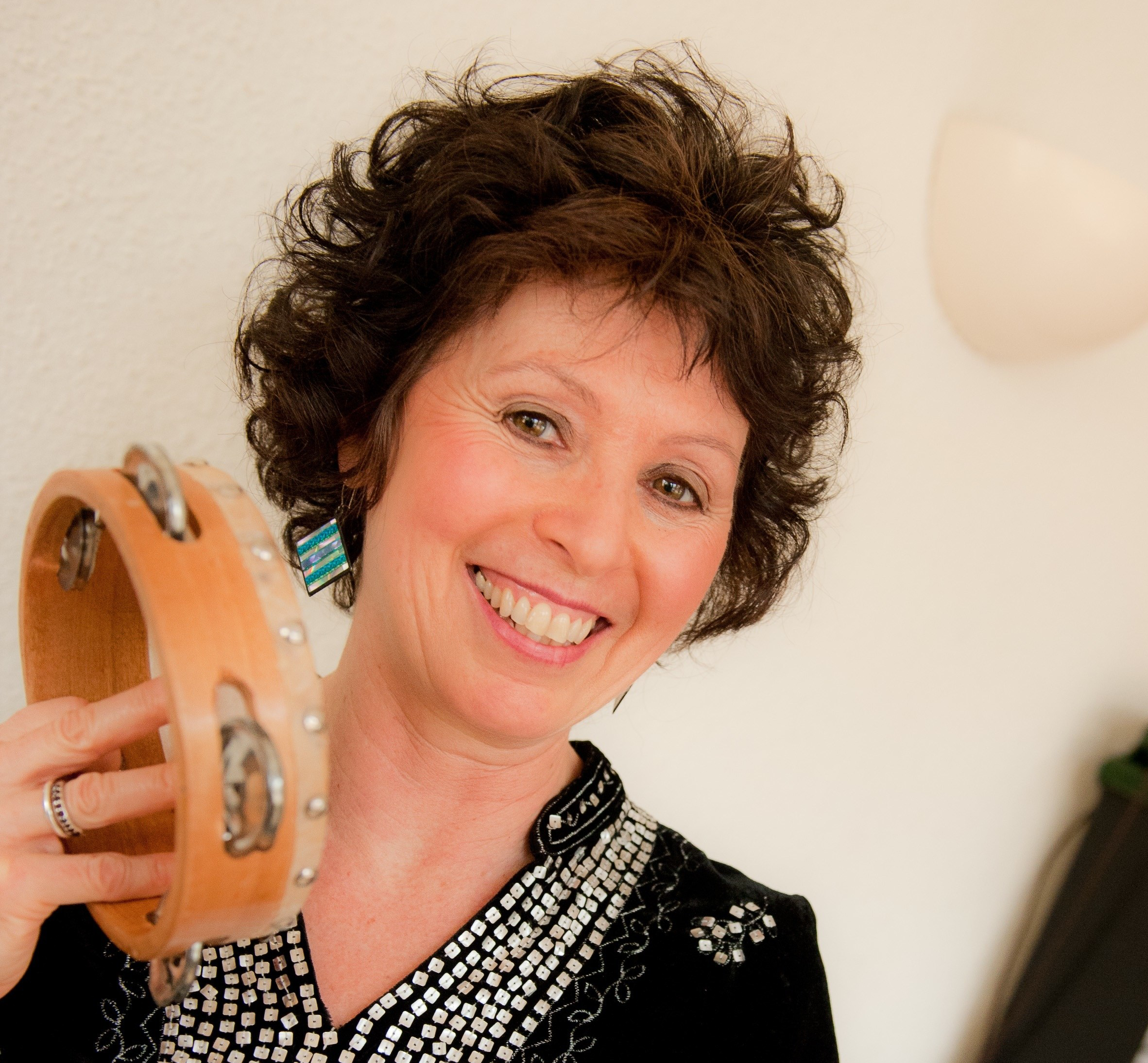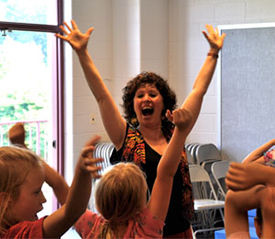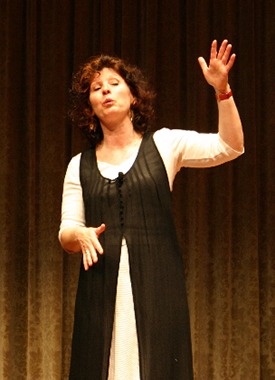Stories of Hope from Noa Baum
Air Date: Week of December 25, 2015

Noa Baum tells traditional tales and creates original stories, such as “A Father’s Gift.” (Photo: Sam Kitner)
Israeli-American storyteller Noa Baum believes that sharing stories keeps hope alive, and she has two examples to demonstrate. First there’s a traditional, Eastern European tale about the importance of stories, and the true recollection of a Pakistani who discovers that his family tree includes people from all over the world and of all faiths.
Transcript
CURWOOD: It’s Living on Earth, I'm Steve Curwood. “Hope for the holidays.” That's the theme we're exploring in the Living on Earth holiday special. Now, if you think about the ancient city of Jerusalem, “hope” might not be the sentiment that immediately comes to mind. It’s an area that’s been torn by sectarian violence, yet sacred to Muslims, Christians, and Jews. Noa Baum grew up in Jerusalem, and she does have hope, hope for peace and understanding. These days Noa lives just outside Washington, DC, and tells stories, traditional and original, to help build bridges of understanding among all people. She’s joining us to share some of those stories and explain why stories are important. Noa Baum, welcome to Living on Earth.
BAUM: Thank you very much, great to be here.
CURWOOD: Now in Jerusalem, I imagine, well, I don't think you see Santa Claus and reindeer and all that in the December holidays, and I also wonder what this time of year is like for you in Washington.
BAUM: Yes, well I certainly didn't grow up with Christmas, but since I've been living here in America I just love this time of the year. The season for me is a symbol of the great spirit of America, the spirit of generosity and inclusiveness. America is a place that strives and values diversity. America for me symbolizes a continuous quest for making things better and insisting on hope, and this time of year more than anything kind of encapsulates this spirit. Hope as a value, and I just love that.
CURWOOD: When do you get news from Jerusalem or talk with family there?
BAUM: Well, that's hard to stay hopeful. I have to admit that these are very dark times, especially for people who wish for peace, strive for peace, work for peace, but the bottom line is that I don't know how to live without hope, and I feel very lucky and privileged to be a storyteller, and grateful for stories because the stories help me stay connected to what's really important and stay connected to this spirit of faith and hope and generosity and inclusiveness – all the wonderful things about humanity. Stories, for me, they are healing, they help us discover the possibilities for better relationships with ourselves and our communities and all of humanity and especially in our Earth, and these are really important things in these times. Stories hold the possibility of peace. When you tell stories and you see the connections that people make, you know that peace is possible, and you have to stay hopeful.
CURWOOD: And so you use stories to help sustain hope. Tell me a story that is powerful enough to sustain one's faith and hope in these times.
BAUM: I don't think there is one. I think every person will find different meaning in different stories, but I want to share with you a little one that speaks to that connection.
CURWOOD: What's it called?
BAUM: It's called, “The Fire in the Forest”.
It is told that in every generation, there are times when hope threatens to leave this world. At such times it is said that the Baal Shem Tov, the great Jewish mystic, would go to a secret place in the forest, where he would light a special fire and say a prayer evoking the most sacred name of the divine, and the danger would be averted, and hope stayed alive.
In later times, when disaster threatened once again, his disciple the Maggid of Mezritch would go to that same place in the forest, but he would lift his eyes to the heavens and say, “Ribono Shel Olam, Master of the Universe, I do not know how to light that fire, but I can say the prayer. Please, let that be enough.”
And it was. And hope stayed in the world.
And still later, when his disciple Rabbi Moshe Leib of Sasov would face dangerous times, he would go to that same place in the forest and say, “Ribono Shel Olam, Master of the Universe, I do not know how to light the fire, nor do I remember the words of the prayer, but I found my way to this place. Please, let that be enough.”
And it was. Hope stayed alive. And many years later, when Rabbi Israel of Rizhyn came to lead the people, he would sit in his armchair with his head in his hands and say, “Ribono Shel Olam, we no longer know how to light the fire nor how to say the prayer. We cannot even find our way to that place, but we can still tell the story. Please, let that be enough.”
And it was. And it still is. For as long as stories are told, hope stays in this world.
CURWOOD: Noa, this is such a powerful story. Where does it come from? What location are you talking about here?
BAUM: It comes from Eastern Europe, where the Baal Shem Tov came from, and where people lived in dire straits and a lot of poverty and suffered a lot of persecution. But I think faith and stories sustain people in hard times. They remind us of the possibilities. They hold the flame of the future. They hold the flame of what's really important, and so I think stories were always used, humor was used, and stories were used to help lift the spirit in dark times.
CURWOOD: Do you have a real-life story for us, Noa?
BAUM: Oh, I have lots of those, but there's one story that's extremely dear to my heart. As part of my work, I use storytelling for peace-building, and I do interfaith workshops between Jews, Muslims, and Christians, where I use the power of story to get people to connect with each other and to start listening to each other and discover their common humanity. And at one of these workshops in Rochester, New York, one of the people who participated in my workshop was a Muslim man from Rochester, Dr. Bilal Ahmed, and he told a story that made my jaw literally drop. And I begged his permission to craft the story for telling, and to tell it to as many people as I can. And so he gave me the permission and this is the true story of a gift that he received from his father.
CURWOOD: And the name of this story?
BAUM: “A Father’s Gift.”
Bilal grew up in Lahore, in the Punjab province of Pakistan. When he was a little boy, there was a war between India and Pakistan, and he asked his father, “Why is there so much hate between the Muslims and the Hindus?”
His father said, “When you're older, I'll explain.”
A few years later when Bilal turned 13, his father took him to his uncle's house in the north. Bilal loved those visits. His uncle’s house was just about the coolest place that you could imagine. The entire house was built around a courtyard, at the center of which was a beautiful fountain. All the rooms of the house, all the doors opened to that courtyard with a fountain. There was an open stairway that led to an open corridor with more doors opening, looking down onto this courtyard. But the best part about that house was the banyan tree in the back. Bilal loved climbing on it with his cousins. They would spend hours there, just hanging out, telling jokes, telling stories.
Bilal was just about to run out there and join his cousins when his father said, “Bilal, come, it's time to answer your question.”
“What question?”
“Come.”
His father took him by the hand and led him up that flight of stairs and along that open corridor. He stopped before the one door, the only door that was ever locked in that house – the attic room. The jinn room. The jinn, the ghosts, the demons. His cousins were always telling stories about the ghosts and demons that lived behind that door.
“Eh, Baba — uh, uh, I don't want to go in there.”
“It's all right. There's something I need to show you. Come.”
His father unlocked the door and led him inside. He pulled the string that lit the single lightbulb from the ceiling. The room was musty and dark. There was old furniture around there and his grandfather's old musket and helmet from the world war. There was a big trunk there that his father now opened, and he took out a book, a big, leather-bound book.
And he said, “Bilal, this is our Bahi, the book of our family's history. It is very old. It is passed through the generations from the oldest son to the oldest son. That is why it is here in your uncle's house, for he is my oldest brother. I want you to look at it, but be careful. It is very old.”
Bilal opened the book. There were some empty pages, and then there was a page with names — oh, about 10 of them. He recognized his name, Bilal Ahmed Sahi, next to his brother Jamal and his sister Sarah. His mother, Naeema Cheema Sahi, his father Gulam Ahmed Sahi.
“Hey, that's us!”
“Yes, his father smiled. “That's us. That's our family. Keep looking.”
And so he started turning the pages. There were about 10 names on each page. He saw the names of cousins and uncles and aunts, people he knew, people he had heard about. Page after page of names.
Suddenly he noticed the names changed.

Storyteller Noa Baum is a Young Audiences educator in Maryland. (Photo: Sam Kitner)
He read, “Singh Gurmeet Singh — Singh Gurmeet Singh Sahi? That's not a Muslim name.”
“No,” his father said. “That is a Sikh name. They are your family too. Keep looking.”
And so he kept turning the pages. The paper was so old it was almost disintegrating in his hand.
And suddenly, he read, “Anil? What's that?”
“That's a Hindu name.”
[GASPS] “Hindu!”
“Yes, they are your family too. Keep looking.”
So he kept turning the pages. After some time it was no longer paper but parchment. And after a while, he couldn't recognize the handwriting or the language.
He looked up at his father and said, “I don't understand. What does this mean?”
His father said, “You asked about the hate. Remember? I wanted you to see this. I wanted you to see that God lives in everything. And don't you ever let anyone tell you to hate another, because you could see, they are all here – Muslims, Sikhs, Hindus, Christians, Jews. They are all your family.”
Well, Bilal was only 13-years-old and all he could think about was how to get out of that musty room and join his cousins on the tree.
Years passed. Bilal left Pakistan. He became a physician, married, three children. Settled in Rochester, New York.
And about two years after his father passed away, Bilal heard about The National Geographic’s Genome Project. The National Geographic’s Genome Project allows people to send samples of their DNA. They analyze it, and they can send you a map that traces the travels of your ancestors throughout history. And if you want, you can also find out who, still living in this world, is genetically related to you. Apparently, there are certain markers that are specific to certain population groups, and if your markers match the markers of someone else, they are genetically related to you, and they give them your e-mail.
And so, Bilal wanted to honor his father's memory, who was so interested in genealogy and history. He sent for the kit.
He took a swab from the inside of his cheek and put it in a little vial with a number on it. No name. No name at all.
And a few weeks later, the results arrived, and there was a great map of the entire world tracing the travels of his ancestors. And like each and every one of us upon this planet, they all began in Africa, and from there migrated over thousands and thousands of years up to Ukraine, Denmark, Poland. And about 5,000 years ago migrated to the area that today is called India, and 1,000 years ago settled in what today is called Pakistan.
And a few weeks later the emails began to arrive, the emails from his genetic relations. And he received an email from somebody called L. Frieberg. Another email came from someone called David Barry Baum, and another from Maurice Krasnow, Clayton Schultz, Jack Salzstein, Ed Leviten. It appears that according to the DNA results, the closest genetic relatives of Dr. Bilal Ahmed, the Pakistani Muslim, are Jews from a small village in eastern Poland.
And it was then that he remembered. He turned to his then-thirteen-year-old daughter and said,
“You know, when I was about your age, my father took me to my uncle’s house and showed me our Bahi, the book of our family's history.”
And he told her the story, and he's been telling that story ever since. He wants his children to always remember his father’s words:
“Don’t you ever let anyone ever tell you to hate another, because you can see they are all here – they are all your family.”
CURWOOD: They are all your family. That sounds like a critical message, wherever there's a conflict, huh?
BAUM: Well, you can understand why my jaw dropped, don't you?
[LAUGHS]
CURWOOD: What happens when you share stories like this?

Baum’s stories draw from diverse cultures and her own Jewish heritage and personal experience. (Photo: Sam Kitner)
BAUM: Oh, my goodness, it’s the greatest gift that you can imagine. That's what allows me to stay hopeful in the world. When I share stories, you just feel that the audience breathes with you, and there's a silence that falls after the story ends. People wipe tears and their face shines, and then they come to me, and they start telling me their stories. It's wonderful. When you hear a good story, it evokes your own stories. It evokes your connection to who you are and to your ancestors and to your heart, and so people start sharing, and you discover how wonderful we really are as humans.
CURWOOD: Indeed, indeed. Noa Baum uses storytelling to build bridges of understanding. She's also author of the upcoming book, “A Land Twice Promised: An Israeli Woman's Quest for Peace.” Before you go, of course, if you have a book, there must be a story behind the book. Can you tell us briefly about it?
BAUM: Yes, and it's the story behind my friendship with a Palestinian woman that I met when I came to this country. And based on our friendship and our family stories, I created a performance piece called, “A Land Twice Promised,” and the book is a memoir of growing up in Jerusalem, coming to this country, meeting her, and the whole process of creating the show and the reactions that I've had around the world to it. It is about sustaining hope.
CURWOOD: Noa celebrates the holidays, and lives year-round for that matter, just outside of Washington, D.C. Noa, thank you so much for taking the time with us today.
BAUM: And thank you so much for having me. Happy holidays to you.
CURWOOD: Happy holidays to you. And if you'd like to get more information about Noa Baum, just go to our website, l-o-e-dot-org.
[MUSIC: “Erev Shel Shoshanim,” written by Josef Hadar]
Links
About Noa Baum’s work with school children
Living on Earth wants to hear from you!
Living on Earth
62 Calef Highway, Suite 212
Lee, NH 03861
Telephone: 617-287-4121
E-mail: comments@loe.org
Newsletter [Click here]
Donate to Living on Earth!
Living on Earth is an independent media program and relies entirely on contributions from listeners and institutions supporting public service. Please donate now to preserve an independent environmental voice.
NewsletterLiving on Earth offers a weekly delivery of the show's rundown to your mailbox. Sign up for our newsletter today!
 Sailors For The Sea: Be the change you want to sea.
Sailors For The Sea: Be the change you want to sea.
 The Grantham Foundation for the Protection of the Environment: Committed to protecting and improving the health of the global environment.
The Grantham Foundation for the Protection of the Environment: Committed to protecting and improving the health of the global environment.
 Contribute to Living on Earth and receive, as our gift to you, an archival print of one of Mark Seth Lender's extraordinary wildlife photographs. Follow the link to see Mark's current collection of photographs.
Contribute to Living on Earth and receive, as our gift to you, an archival print of one of Mark Seth Lender's extraordinary wildlife photographs. Follow the link to see Mark's current collection of photographs.
 Buy a signed copy of Mark Seth Lender's book Smeagull the Seagull & support Living on Earth
Buy a signed copy of Mark Seth Lender's book Smeagull the Seagull & support Living on Earth

